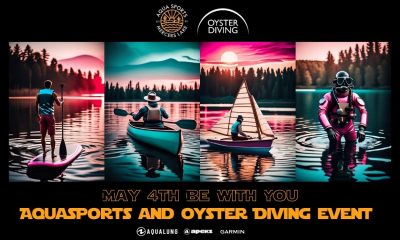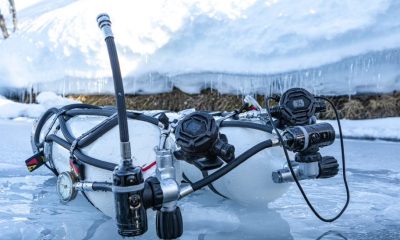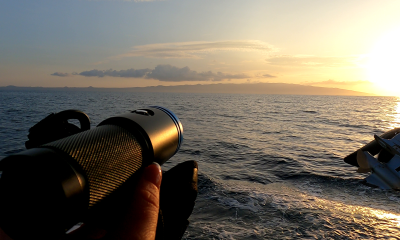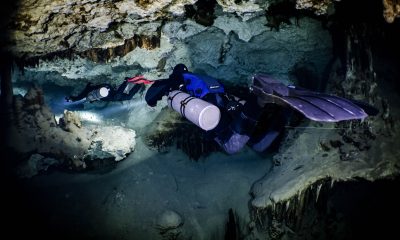News
Ikelite release housing for Sony RX100 VI

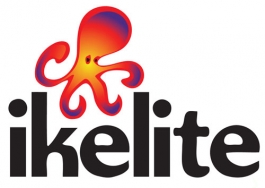 Ikelite have produced a full featured and durable underwater housing for Sony Cyber-shot RX100 VI digital cameras. Perfect for scuba, snorkel, surf, pool, and any application in or around the water.
Ikelite have produced a full featured and durable underwater housing for Sony Cyber-shot RX100 VI digital cameras. Perfect for scuba, snorkel, surf, pool, and any application in or around the water.
Key Features
- Durable and corrosion-free ABS-PC construction
- Depth rated to 200 feet (60m)
- Ergonomic access to all important camera functions
- Support for the attachment of external wide angle and macro lenses
- Compact and lightweight
- Optional vacuum testing system
- Made in USA
Availability
Ikelite are accepting pre-orders now and will start shipping in 1-2 weeks. Pre-orders will be fulfilled on a first-come, first-served basis.
About the Sony RX100 VI camera
Sony’s 2018 model in the huge RX100 series sports an extended, 24-200mm f/2.8-4.5 zoom lens with enhanced image stabilization. Having a longer zoom reach compared to previous RX100 models makes this a great choice for overall travel photography.
A large 20MP 1″ sensor and incredibly fast autofocus make for great images above and below the surface… plus stunning 4K UHD video recording all in one very compact body.
Construction
Our ABS-PC blend housing provides strength and corrosion free performance year with minimal maintenance. The specially formulated color deflects the sun to keep your camera running cooler, longer. Compared to black or clear housings, the light color provides superior contrast for enhanced view of the camera, LCD screen, and o-ring seal.
Ikelite products are designed, built and tested in the USA. We use locally sourced, top-grade materials. Our housings are built by hand and individually tested for fit, function and waterproof integrity. We back our products with over 50 years of experience and service within the dive industry.
Ergonomics
A slide-in, front loading camera mount makes this housing a breeze to set up and shoot. Controls are provided for all important camera functions including front and rear control dials. Controls are placed in an intuitive position and designed for comfortable access whether you’re holding the housing or an add-on handle.
A sensitive shutter lever makes it easy to half-depress the trigger for focusing and metering. Rear push button controls are laser engraved for identification with a new bright red push button for the video record start/stop.
The camera’s large LCD screen can be seen clearly through the back of the housing. The screen can be tilted during installation for more comfortable viewing underwater.
Use the camera’s built-in WiFi feature to download photos to another device without removing the camera from the housing. The WiFi feature is only usable above water within close proximity to the connected device.
Flash
Due to the position of the camera’s flash in relation to its lens, the built-in flash is not suitable to illuminate photos under water. For the best color and clarity, we recommend adding a filter, strobe, or constant-on light. The built-in flash may be used to trigger external strobes via fiber optic sync cord. Two ports are provided for the connection of up to two fiber optic cords.
Any Ikelite DS strobe may be connected using the Fiber Optic Converter # 4401.1 and Fiber Optic Cord # 4501. The AF35 strobe is not compatible with this housing.
The optional Action Tray II with Left Handle # 2605.04 and Action Tray II Extension with Right Handle # 2605.05 provide a balanced grip and are the perfect platform for adding lighting accessories.
The Action Tray II mounts to the bottom of the housing with two 1/4-20 threaded screws for secure and rotation-free use. Our uniquely curved grips are rubberized for a comfortable grip and provide a quick release mechanism for adding and removing light arms.
Zoom, super macro, and semi-wide angle
The standard 3.9″ diameter optical glass port accommodates the camera’s full 24-200mm zoom range underwater.
Add the press-fit Macro Adapter # 9306.82 with any 67mm threaded macro wet lens for incredibly super macro photography. Compatible wet lenses include but are not limited to the INON UCL-165, Subsee Magnifier, Saga close up lenses, Nauticam CMC-1, and others.
The optional WD-4 Wide Angle Dome # 6430.4 provides a wider angle of view underwater without the edge distortion, vignetting, or weight typically associated with an external wide angle wet lens. The WD-4 is a 0.75x magnification factor and simply slides on and off of the housing’s lens port.
3.9″ diameter color filters press directly onto the front of the standard lens port. We offer color filters for Tropical Blue Water # 6441.46, Green Water # 6441.86, and a Yellow Barrier Filter # 6441.16 for fluorescence photography.
Optional wide angle port
The optional Wide Angle Port M67 for Sony RX100 VI # 9306.02 can be used in place of the housing’s standard port for use of 67mm threaded external wide angle wet lenses. This port has been optimized to provide the best combination of wide angle and macro photography. The shorter port length accommodates an effective zoom range of 24-70mm.
This port is optimized for use with wide angle wet lenses designed for the 28mm equivalent focal length, including the INON UWL-H100, Nauticam WWL-1, and others. Some vignetting (dark shadows around the edges of the image will be present at wider focal lengths. We recommend zooming to eliminate vignetting or cropping your images in post-production.
The front of the port also accepts 67mm threaded macro wet lenses by INON, Subsee, Saga, Nauticam, and others.
The standard lens port is removed and the Wide Angle Port M67 simply threads into the front of the housing for quick and easy installation. The camera cannot be zoomed past 70mm with this port attached. The camera will shut down if zoomed past this point.
Sealing and Vacuum Testing
There is no greater assurance than being able to see your camera and o-ring seal through the back of the housing. Our signature open-groove design suspends the rear o-ring in a natural position that is easier to maintain and more reliable than forcing the o-ring into a channel. Once the housing is closed you can see the o-ring form a solid, waterproof seal.
A spare 1/2-20 threaded accessory port is provided on the side of the housing for easily installation of the optional Vacuum Kit # 47012. A hand pump with gauge allows you to draw a vacuum on the housing to simulate water pressure and check for leaks prior to entering the water.
Every unit is water pressure tested to 200 feet (60m) before it leaves our facility in Indianapolis.
Compatibility
Older RX100 Mark I, II, III, IV, and V cameras are not usable in this housing due to differences in lens and control placement. The Sony AG-R2 Attachment Grip is not compatible with this product.
For more information please visit the ikelite website by clicking here.
Blogs
Northern Red Sea Reefs and Wrecks Trip Report, Part 2: Wall to Wall Wrecks

Jake Davies boards Ghazala Explorer for an unforgettable Red Sea diving experience…
The second day’s diving was a day full of wreck diving at Abu Nuhas, which included the Chrisoula K, Carnatic, and Ghiannis D. The first dive of the day was onto the Chrisoula K, also known as the wreck of tiles. The 98m vessel remains largely intact where she was loaded with tiles which can be seen throughout the hold. The stern sits at 26m and the bow just below the surface. One of the highlights of the wreck is heading inside and seeing the workroom where the machinery used for cutting the tiles are perfectly intact. The bow provided some relaxing scenery as the bright sunlight highlighted the colours of the soft coral reef and the many reef fish.

Following breakfast, we then headed to the next wreck, which was the Carnatic. The Carnatic is an 89.9m sail steamer vessel that was built in Britain back in 1862. She ran aground on the reef back in 1869 and remains at 27m. At the time, she was carrying a range of items, including 40,000 sterling in gold. An impressive wreck where much of the superstructure remains, and the two large masts lay on the seafloor. The wooden ribs of the hull provide structures for lots of soft corals, and into the stern section, the light beams through, bouncing off the large shoals of glass fish that can be found using the structure as shelter from the larger predators that are found outside of the wreck.

The final wreck at Abu Nuhas was the Ghiannis D, originally called ‘Shoyo Maru,’ which was 99.5m long and built in Japan back in 1969 before becoming a Greek-registered cargo ship in 1980. The ship then ran aground on the reef on April 19th, 1983, and now sits at the bottom at a depth of 27m. Heading down the line, the stern of the ship remains in good condition compared to the rest of the hull. The highlight of the wreck, though, is heading into the stern section and down the flights of stairs to enter the engine room, which remains in good condition and is definitely worth exploring. After exploring the interior section of the ship, we then headed over to see the rest of the superstructure, where it’s particularly interesting to see the large table corals that have grown at the bow relatively quickly considering the date the ship sank. After surfacing and enjoying some afternoon snacks, we made sure everything was strapped down and secured as we would be heading north and crossing the Gulf of Suez, where the winds were still creating plenty of chop.

The next morning, it was a short hop to Ras Mohammed Nature Reserve for the next couple of days of diving. The 6am wake-up call came along with the briefing for the first site we would be diving, which was Shark & Yolanda. The low current conditions allowed us to start the dive at Anemone City, where we would drift along the steep, coral-filled wall. These dives involved drifts, as mooring in Ras Mohammed wasn’t allowed to protect the reefs. As a dive site, Shark & Yolanda is well-known and historically had a lot of sharks, but unfortunately not so many in recent years, especially not so early in the season. However, there was always a chance when looking out into the blue.

The gentle drift took us along the steep walls of the site, with plenty of anemone fish to be seen and a huge variety of corals. It wasn’t long into the dive before we were accompanied by a hawksbill turtle, who drifted with us between the two atolls before parting ways. Between the two reefs, the shallow patch with parts of coral heads surrounded by sand provided the chance to see a few blue-spotted stingrays that were mainly resting underneath the corals and are always a pleasure to see. With this being the morning dive, the early sunlight lit up the walls, providing tranquil moments. Looking out into the blue, there was very little to be seen, but a small shoal of batfish shimmering underneath the sunlight was a moment to capture as we watched them swim by as they watched us.

Towards the end of the dive, we stopped at the wreck of the Jolanda where the seafloor was scattered with toilets from the containers it was carrying. This provided a unique site to make a safety stop, which was also accompanied by a large barracuda slowly swimming by, along with a hawksbill turtle calmly swimming over the reef as the sun rays danced in the distance.
For the next dive, we headed north to the Strait of Tiran to explore the reefs situated between Tiran Island and Sharm El Sheik, which were named after the British divers who had found them. We started on Jackson before heading to Gordons Reef, where we also did the night dive. All the atolls at these sites provided stunning, bustling coral reefs close to the surface and steep walls to swim along, which always provided the opportunity to keep an eye out for some of the larger species that can be seen in the blue. Midwater around Jackson Reef was filled with red-toothed triggerfish and shoals of banner fish, which at times were so dense that you couldn’t see into the blue. Moments went by peacefully as we enjoyed the slow drift above the reef, watching these shoals swim around under the mid-afternoon sun.

The night dive at Gordon’s Reef was mainly among the stacks of corals surrounded by sand, which was great to explore under the darkness. After some time circling the corals, we came across what we were really hoping to find, and that was an octopus hunting on the reef. We spent the majority of the dive just watching it crawl among the reef, blending into its changing surroundings through changes in colour and skin texture. It’s always so fascinating and captivating to watch these incredibly intelligent animals, in awe of their ability to carry out these physical changes to perfectly blend into the reef. Before we knew it, it was time to head back to the boat to enjoy a well-deserved tasty dinner prepared by the talented chefs onboard.
Check in for the 3rd and final part of this series from Jake tomorrow!
To find out more about the Northern Red Sea reef and wrecks itineraries aboard Ghazala Explorer, or to book, contact Scuba Travel now:
Email: dive@scubatravel.com
Tel: +44 (0)1483 411590
Photos: Jake Davies / Avalon.Red
Marine Life & Conservation
Double Bubble for Basking Sharks

 The Shark Trust is excited to announce that, for two more days only, all donations, large or small, will be doubled in the Big Give Green Match Fund!
The Shark Trust is excited to announce that, for two more days only, all donations, large or small, will be doubled in the Big Give Green Match Fund!
Donate to Basking in Nature: Sighting Giants
The Shark Trust is hoping to raise £10k which will be doubled to £20k. This will go towards Basking in Nature: Sighting Giants. And they need YOUR help to reach they’re goal.
The Shark Trust’s citizen science project is to monitor and assess basking sharks through sightings; encouraging data collection, community engagement, and promoting nature accessibility. This initiative aims to enhance health and wellbeing by fostering a deeper connection with British Sharks.
Campaign Aims
- Increase citizen science reporting of Basking Sharks and other shark sightings to help inform shark and ray conservation.
- Provide educational talks about the diverse range of sharks and rays in British waters and accessible identification guides!
- Create engaging and fun information panels on how to ID the amazing sharks and rays we have on our doorstep! These can be used on coastal paths around the Southwest. With activities and information on how you can make a difference for sharks and rays!
- Promote mental wellbeing through increasing time in nature and discovering the wonders beneath the waves!
Donate, and double your impact. Click Here
-

 News3 months ago
News3 months agoHone your underwater photography skills with Alphamarine Photography at Red Sea Diving Safari in March
-

 News3 months ago
News3 months agoCapturing Critters in Lembeh Underwater Photography Workshop 2024: Event Roundup
-

 Marine Life & Conservation Blogs2 months ago
Marine Life & Conservation Blogs2 months agoCreature Feature: Swell Sharks
-

 Blogs2 months ago
Blogs2 months agoMurex Resorts: Passport to Paradise!
-

 Blogs2 months ago
Blogs2 months agoDiver Discovering Whale Skeletons Beneath Ice Judged World’s Best Underwater Photograph
-

 Gear Reviews2 months ago
Gear Reviews2 months agoGear Review: Oceanic+ Dive Housing for iPhone
-

 Marine Life & Conservation2 months ago
Marine Life & Conservation2 months agoSave the Manatee Club launches brand new webcams at Silver Springs State Park, Florida
-

 News3 months ago
News3 months agoWorld’s Best Underwater Photographers Unveil Breathtaking Images at World Shootout 2023





